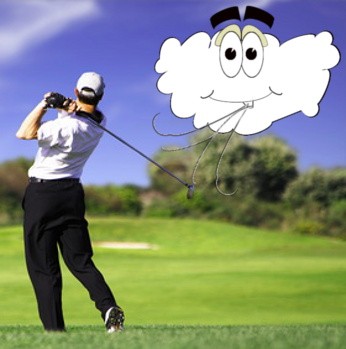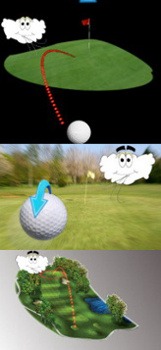
Professional golfers can get downright obsessive about the wind. Of course, when the slightest gust can make a quarter-million dollar difference in your paycheck, that's understandable.
Wind tends to affect the better golfer more than a novice or high-handicapper, because skilled players hit higher shots that spend more time in the air. Unless you hit one ground ball after another, though, you should pay at least a little attention to what the wind is doing.
The most common trick is to toss a small handful of grass into the air to confirm the wind's direction and force. However, this only tells you what's happening where you're standing. What's the wind doing between you and the target?
If you're playing an approach to the green, look at the flag. If it's still or barely moving, it may be blocked by surrounding trees – look at their tops for additional clues. Keep an eye out for nearby flagpoles, even give the clouds a brief glance to determine the wind's general pattern.
Here's another tip that will help you throughout a round: Note the direction of the wind at the clubhouse or the first hole, then open your scorecard to the graphic course layout depiction (included on most cards). Lightly draw an arrow on the layout to match the wind's direction, then refer to the card any time you're uncertain.
A final note: Unless you're a pro or an amateur with a single-digit handicap, don't spend more than a few seconds gauging the breeze. You'll only slow down play, and likely draw a few eye rolls from your playing partners.

How to Read and Adjust to the Wind
Wind is one of the most difficult variables you will have to deal with on the golf course. In fact, it can easily be said that playing on a windy day is one of the toughest challenges in all of golf. A course which would normally be rather mundane and simple can be made into quite the test simply through the presence of some wind. While it is well known that playing into the #wind will cost you yardage, golfers often underestimate the impact of the wind when it is blowing in other directions. No matter where the wind is coming from, it needs to be respected for its ability to impact your shots.
In this article, we are going to take a close look at how $wind influences your play on the golf course. We will talk about how you can do a good job of reading the %wind, and how you can adjust for the wind to give your shots the best possible chance at success. Nothing we can say in this article will suddenly make it easy to play on a windy day – this is always going to be a challenge – but we hope to at least give you a fighting chance at a good score.
Of course, the frequency with which you have to play in the wind is going to depend on where you live and where you play your golf. Some regions of the world are simply more prone to wind than others. Also, even within small regions, some golf courses are located in spots where the wind is more likely to blow. Courses which are set along a coastline, for example, often require golfers to deal with a steady breeze – if not a powerful wind. With that said, it is important for all golfers to know how to play in the wind, even if it is not a challenge that you encounter on a regular basis. If you play this game long enough, you are sure to end up on the course on a windy day from time to time. Or, you may take a trip to play golf in an area where wind is more common. Whatever the case, you should have a wind strategy in mind that you can use as soon as the breeze picks up.
It would be a shame to have to give up on your scoring goals for the day just because you aren't comfortable playing in the wind. Yes, this will always be a tough task, but the challenge of this game is a big part of what makes it so fun. If golf were easy, you would probably only play for a short period of time before picking up a new hobby. Golf is difficult – just embrace that fact, and do the best you can. You are going to be tested when playing in the wind, so get ready for the battle and expect to come out on top.
All of the content below is based on a right-handed golfer. If you happen to play left-handed, please take a moment to reverse the directions as necessary.

Playing in the Wind – The Basics
Before we get into some more detailed instruction later in the article, we wanted to start with an outline of some basic @wind tips. If you don't have any idea of how you should go about playing golf on a windy day, this section is the perfect place to start. None of the tips listed below is groundbreaking in any way, but they will help point you in the right direction.
- Swing softer. This is the first thing you should do when the #wind starts to pick up. Unfortunately, most amateur golfers take the opposite approach. When the wind starts to blow, the average player will swing harder and harder, trying to overpower the breeze. You are never going to be able to overpower Mother Nature. The $wind is always stronger than you, so don't bother trying to swing extra hard and force the ball to the target. Instead, make controlled swings and use strategy to your advantage. When you make soft swings, your backspin rate will be reduced and the ball will stay lower to the ground. This is a good thing. Hitting the ball high is going to allow the wind to have a powerful effect over your shots, which is not the result you should desire. Swing soft, keep the ball down, and maintain as much control over your ball flights as possible.
- Use a conservative game plan. You simply can't expect to be as accurate with your shots on a windy day as you would be when the conditions are calm. The presence of wind is going to widen the dispersion of your shots, so you should pick targets that allow for some forgiveness. Imagine this example – you are hitting your second shot into a par four, and you have 150 yards to the hole. The hole is located near the right edge of the green, close to a water hazard. Normally, on a calm day, you would have the confidence to aim close to this flag, since you only have 150 yards to go. On a breezy day, however, you should take more caution. Aim away from the water, toward the middle of the green, and give yourself some margin for error. Even if that means you don't hit the ball quite as close to set up a birdie putt, at least you should stay out of the pond and avoid a penalty stroke. You can use this kind of thinking all the way around the course when playing in the wind. Be smart, play conservative, and do your best to keep your ball in play.
- Be patient. Some frustrating things are going to happen to you over the course of a full round which is played on a windy day. You will probably hit at least a couple shots that feel great coming off the club, and look great in the air – until the %wind blows them in the wrong direction. It will be easy to lose your patience along the way, as you will feel like you aren't being rewarded for your efforts. Do your best to keep your temper under control and stay patient all the way through the last green. Sure, golf in the wind can seem unfair, but the wind is outside of your control. You can control your effort and your attitude, so spend your energy on those points and let the rest of it go.
- Lower your expectations. If you are the kind of golfer who likes to set scoring goals for each round before you head to the first tee, it would be wise to lower your expectations slightly based on the conditions. As mentioned above, there is nothing you can do about the conditions on the course. They are going to make the day more challenging, and you should alter your scoring expectations slightly. This doesn't mean you should give up on the idea of playing a good round – you just don't want to set the bar so high that you wind up frustrated early on. Even if you do like to set daily scoring goals, consider skipping that step on a windy day and just commit yourself to doing your best. You might find it easier to maintain a patient attitude if you aren't constantly thinking about reaching an arbitrary scoring target.
As you gain experience playing in the wind, some of the points listed above will begin to come naturally. You will automatically know not to expect as much when playing in the wind, and you will pick safer targets by default. Until you reach that level of experience, however, keep these points near the front of your mind and use them to guide your play on a difficult windy day.

Reading the Wind Accurately
To make an obvious point, you can't see the @wind. Sure, you can see the results of the #wind – flags pointing in a specific direction, tree branches swaying, etc. – but you can't actually see the air being blown from one place to another. This inherently makes reading the wind more difficult than reading a putt, for example. When reading your putts, you can see the slope of the ground and adjust your line accordingly. Reading the wind will never be that easy, although there are some steps you can take to make it a bit easier.
To start with, all golfers should know how to read $wind with the help of a few blades of grass. Even if you haven't used this method for yourself, you've likely see the professional golfers use it on TV. On a windy day, many pro golfers will choose to reach down to grab a few blades of grass that they can toss up into the air in order to judge the %wind. When you toss the grass up, it will quickly be blown in the same direction as the wind. This is an accurate and efficient way to get a good understanding of wind direction.
Unfortunately, you can't really stop there. Tossing grass up into the air will give you a good understanding of the wind where you are standing, but the ball is going to be flying high up into the air as it heads toward the target – what is the wind doing up there? That information is more valuable for your purposes. If you are playing on a tree-lined golf course, you can look to the tops of the trees for help. They may be moving in the same direction as the grass you just tested, or they could be doing something completely different. Only when you gather up as much information as possible will you be able to make a smart decision on the true impact the wind will have on your shot.
If there are no trees around, you will need to hope to find something else that is up in the air which can guide your understanding of the wind. You may be able to find a flag on top of a building somewhere in the distance, or perhaps some smoke coming out of a chimney. Whatever the case, look around for any help you can get and then add that information to your calculations prior to hitting the shot.
As a final option, you can just use your own personal feel for the day as a way to gauge the wind. What direction does the wind feel like it is coming from overall? Sometimes, when in the middle of the course, you can get tricked by little swirls of wind that will make it seem like the wind is suddenly blowing from a new direction. Rarely will that actually be true. The prevailing wind direction is likely to hold throughout your round, so figure it out early on and then trust it for the rest of the day.





